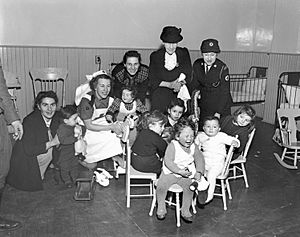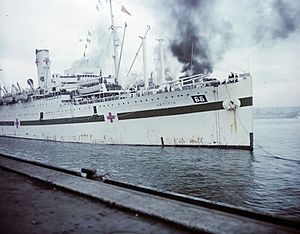Pier 21 facts for kids
Quick facts for kids Pier 21 |
|
|---|---|

Pier 21 in 1934 with RMS Majestic
|
|
| Location | Halifax, Nova Scotia, Canada |
| Area | 221,000 square feet (20,500 m2) |
| Built | 1928 |
| Official name: Pier 21 National Historic Site of Canada | |
| Designated | September 22, 1997 |
| Lua error in Module:Location_map at line 420: attempt to index field 'wikibase' (a nil value). | |
Pier 21 was a very important place in Halifax, Nova Scotia, Canada. From 1928 to 1971, it was a busy port where huge ships, called ocean liners, arrived. It was also a special building where new immigrants to Canada were welcomed.
Almost one million immigrants came to Canada through Pier 21. It is the last building of its kind still standing in Canada. Many people compare it to Ellis Island, a famous immigration spot in the United States. Today, the old immigration building is home to the Canadian Museum of Immigration at Pier 21. It also houses the Nova Scotia College of Art and Design and many shops.
Contents
Why Was Pier 21 Built?
Long ago, in the age of steamships, Halifax Harbour was a main entry point for people coming to Canada. Other important ports were Quebec City and Victoria, British Columbia. Before Pier 21, there was an older building called Pier 2 in Halifax. It was built in 1880 to help new arrivals.
Pier 2 also served as a major hub during World War I. Many soldiers left from there, and hospital ships brought wounded soldiers back. By 1913, Canada saw a huge number of immigrants. It became clear that a bigger, better facility was needed. Ships were also getting much larger. So, plans were made for a new, modern port in the South End of Halifax.
Building the New Pier 21
Building the new port was delayed by World War I and a huge event called the Halifax Explosion. But by 1928, the new "ocean terminals" were finished. This was a big complex with piers for cargo, tall buildings for storing grain, and a new train station.
The main part was a two-story building, about 600 feet long. This building became Pier 21. It had a huge area of 221,000 square feet for cargo. It was made of strong steel with brick walls and wooden roofs. This large building was divided into Pier 20, 21, and 22. It faced a long wall where even the biggest ocean liners could dock.
The immigration area was on the second floor of Pier 21. It had a large hall where immigrants gathered. There were also rooms for medical checks and for people who needed to wait. Next to Pier 21 was a two-story brick building, called the annex. A walkway connected it to the main shed.
The annex held offices for immigration and customs. It also had a railway ticket office and a telegraph office. Charities like the Canadian Red Cross had offices there too. There was even a restaurant where immigrants could eat before their long train journeys. Trains waited on tracks next to the annex. Special immigrant trains, with many "colonist cars," took people to their new homes across Canada. Another walkway went over the tracks to the main Halifax, Nova Scotia railway station. Richer travelers could catch regular trains there.
A Busy History of Pier 21
Pier 21 officially opened on March 8, 1928. The first ship to bring immigrants was the SS Nieuw Amsterdam (1905). It belonged to the Holland America Line. Pier 21 was seen as "the finest on the continent." It was designed to make Canada a top choice for Atlantic travel.
Pier 21 was a passenger terminal for ocean liners from 1928 until 1971. It was the main entry point for almost one million immigrants and refugees. These people came from Europe and other parts of the world. It was also the departure point for 496,000 Canadian troops during World War II. Because of this, Pier 21 became known as the 'Gateway to Canada.'
In its early years, Pier 21 welcomed many Dutch and English immigrants. But the Great Depression caused fewer people to come. During this time, Pier 21 also became a stop for cruise ships. Huge liners like the RMS Olympic and RMS Majestic visited Halifax.
Pier 21 During World War II
World War II almost stopped immigration. But Pier 21 quickly became a major port for troop ships. Canadian and other Allied soldiers boarded hundreds of ships here. These included giant liners like the RMS Queen Mary and RMS Queen Elizabeth.
As the war went on, a special medical unit was set up at Pier 21. It helped move wounded soldiers from hospital ships to special hospital trains. Over 90,000 pilots came to Canada through Pier 21 for the British Commonwealth Air Training Plan. More than 2,000 children from the United Kingdom also arrived here. They were escaping the bombings during the war.
Important people also passed through Pier 21. Princess Juliana and Prince Bernhard of the Netherlands arrived in 1940. They were seeking safety in Ottawa. Winston Churchill, the British Prime Minister, came through Pier 21 four times. He was on his way to important meetings in Canada and the USA.
Huge amounts of gold were secretly shipped through Pier 21 during the war. This gold belonged to European countries and was kept safe in Canadian banks. Britain alone sent over 2.5 billion in gold! At the end of the war, Pier 21 welcomed returning soldiers. Then, it welcomed their war brides who came to join them. A big fire damaged Pier 21 in 1944. But it was rebuilt quickly to handle the returning soldiers and war brides in 1945.
After the War: New Waves of Immigrants
After the war, many new groups of immigrants arrived at Pier 21. First came refugees from all over Europe. This included many Holocaust survivors. Then came many people looking for work from countries like Britain, Italy, Germany, and the Netherlands.
One of the smallest ships to ever come to Pier 21 was the SS Walnut in 1948. It was packed with 347 refugees from the Baltic region. This event caused a big discussion about Canada's refugee rules. The 1950s were the busiest years for immigration. Many Italian-Canadians arrived during this time. A large two-story addition was built onto the annex to handle all the new arrivals.
The Hungarian Revolution of 1956 brought another group of refugees to Pier 21. However, some refugees were now starting to arrive by airplane. In the 1960s, jet airliner travel became popular. This meant fewer people traveled by ocean liner. So, immigration started to shift to airports. Pier 21 was used less often.
The last major group of immigrants were 100 Cuban refugees in 1970. They were transferred to Pier 21 while their claims were processed. Pier 21 closed its doors on March 28, 1971. The last ship to bring immigrants to Pier 21 was the SS Nieuw Amsterdam (1937). It had the same name as the very first ship that arrived in 1928.
What Happened to Pier 21 After It Closed?
From the 1970s to 1991, the old immigration building at Pier 21 was used as a training school for sailors. In the 1990s, artists used the space for their studios. Customs officials and port police used the immigration annex building.
In the 1980s, the cruise ship industry grew. Large passenger ships returned to Pier 21, but only for short visits. Some parts of the old immigration terminal were changed into areas for cruise ship passengers and shops.
On September 22, 1997, Pier 21 was named a National Historic Site of Canada. This was because of its huge role in Canadian immigration in the 20th century. It was also important because it was the last seaport immigration building left in Canada.
In 1999, the Pier 21 Society opened a special center there. It helped people learn about the history of immigration. In 2010, this society became the Canadian Museum of Immigration at Pier 21. It took over a larger part of the old building. The Nova Scotia College of Art and Design moved into Pier 21's old medical and detention areas in 2011. Today, the immigration annex also has a brewery, shops, and studios for artists and architects.





